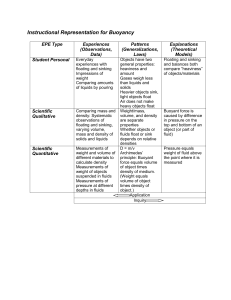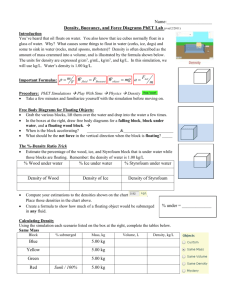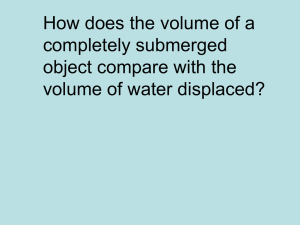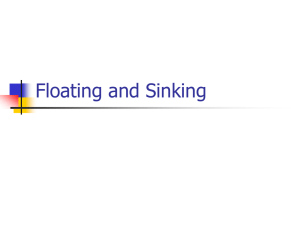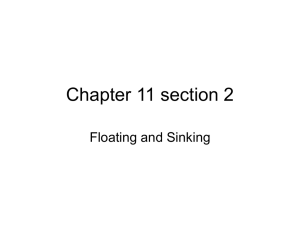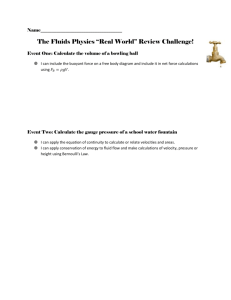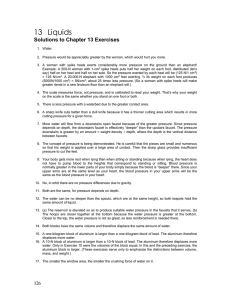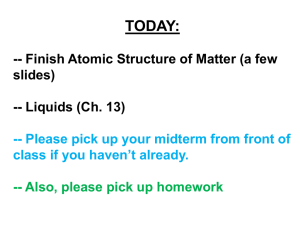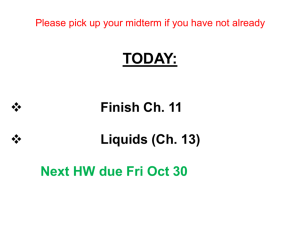Back Questions on Fluids and Buoyancy
advertisement
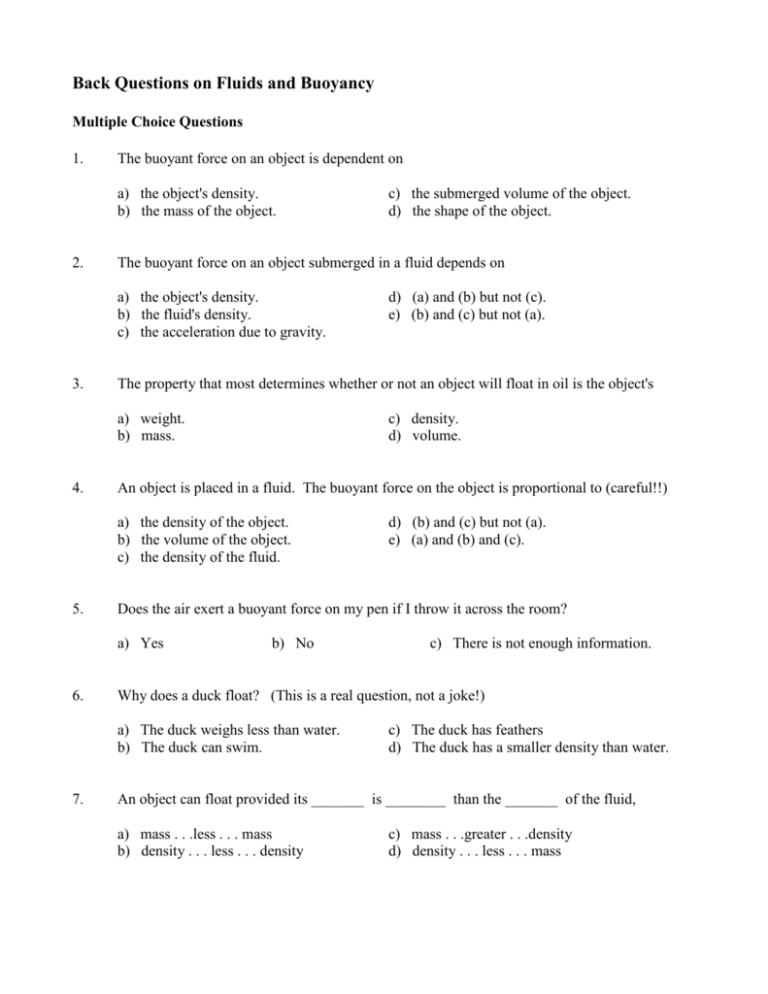
Back Questions on Fluids and Buoyancy Multiple Choice Questions 1. The buoyant force on an object is dependent on a) the object's density. b) the mass of the object. 2. The buoyant force on an object submerged in a fluid depends on a) the object's density. b) the fluid's density. c) the acceleration due to gravity. 3. c) density. d) volume. An object is placed in a fluid. The buoyant force on the object is proportional to (careful!!) a) the density of the object. b) the volume of the object. c) the density of the fluid. 5. b) No c) There is not enough information. Why does a duck float? (This is a real question, not a joke!) a) The duck weighs less than water. b) The duck can swim. 7. d) (b) and (c) but not (a). e) (a) and (b) and (c). Does the air exert a buoyant force on my pen if I throw it across the room? a) Yes 6. d) (a) and (b) but not (c). e) (b) and (c) but not (a). The property that most determines whether or not an object will float in oil is the object's a) weight. b) mass. 4. c) the submerged volume of the object. d) the shape of the object. c) The duck has feathers d) The duck has a smaller density than water. An object can float provided its _______ is ________ than the _______ of the fluid, a) mass . . .less . . . mass b) density . . . less . . . density c) mass . . .greater . . .density d) density . . . less . . . mass 8. A wooden boat with a density of 0.48 g/cc is floating in a vat of oil whose density is 0.80 g/cc. What percentage of the boat is floating above the surface of the oil? a) 42 % b) 60 % 9. Will an object that floats in water also float in the oil from the previous question? a) Yes 10. b) No c) There is not enough information. Oil has a smaller density than water. Therefore, an object that will float in oil will a) b) c) d) e) 11. c) 52 % d) 40 % float in water, with more of the object submerged. float in water, with the same amount of the object submerged. float in water, with less of the object submerged. not float in water. There is not enough information. A boat with a density of 0.75 g/cc is floating in water. What percentage of the boat is floating above the surface of the water? a) 25 % b) 50 % c) 75 % d) None; the boat will actually sink! 12. This was a lousy question, so I have removed it from the back questions. However, actually removing it would make me renumber everything, so instead you just have to read this, since I didn’t feel like doing that. 13. So was this one 14. The pressure at an underwater depth of 33.7 feet is 2 atmospheres (atm). At what depth would the pressure be 3 atm? a) 67.4 feet. d) 50.55 feet. 15. This one was REALLY bad. c) 101.1 feet d) The pressure can never reach 3 atm. 16. The pressure at an underwater depth of 33.7 feet is 2 atmospheres (atm). At what depth would the pressure be 4 atmospheres? a) 67.4 feet b) 134.8 feet 17. c) 101.1 feet d) The pressure can never reach 4 atm. A 20 kg solid block of Aluminum (Al = 2.70 g/cc) is placed in a beaker of water filled to the brim. Some water overflows. The same is done in another beaker with a 20 kg solid block of lead (lead = 11.3 g/cc) Does the block of lead displace more, less, or the same amount of water as the aluminum block? a) More b) Less 18. c) The same amount. d) There is not enough information. If, in problem 17, we continue to use a 20 kg solid block of aluminum, but instead of a 20 kg block of Lead we use a 10 kg block of lead, does the block of lead displace more, less, or the same amount of water as the aluminum block? a) More b) Less 19. c) The same amount. d) There is not enough information. If, in problem 17, we continue to use a 20 kg solid block of aluminum, but instead of a 20 kg block of Lead we use a 80 kg block of lead, does the block of lead displace more, less, or the same amount of water as the aluminum block? a) More b) Less 20. c) The same amount. d) There is not enough information. Which has a greater buoyant force acting on it, a floating 100 lb piece of wood, or a floating 50 lb piece of wood? a) The 100 lb piece of wood. b) The 50 lb piece of wood. c) Since both pieces of wood are floating, they experience the same buoyant force. d) There is not enough information. Answer Key: 1. C 2. E 3. C 4. C 5. A 6. D 7. B 8. D 9. C 10. C 11. A 12. A 13. A 14. A 15. D 16. C 17. B 18. B 19. B 20. A 21. B Short Answer Questions 1. A rectangular block is floating in a large pot of pure water. The block is floating with one-half of its volume submerged. Salt is slowly poured into and then dissolved into the water. What, if anything, will happen to the block as the salt is introduced into the water? Why? Note that a guess without an explanation will not get much credit. (Ans: block rises) 2. A ship sailing from the ocean (salt-water) into a fresh-water harbor sinks slightly deeper into the water. Does the buoyant force on the ship change? Why or why not? If so, does the buoyant force increase or decrease? If not, why does the ship sail lower in the water? (Ans: B doesn’t change) 3. Use whatever knowledge you have to determine the density of air. Hints: (1) For the purposes of calculating air pressure at sea level, the atmosphere can be taken to be 10 miles high, there are 5280 feet in a mile. (2) The density of water is 1.00 g/cc. (3) All of the necessary information to solve this problem can be found somewhere in this question package. (Ans: 3.2 104 g/cc) 4. An ice cube measures 10 cm on a side, and floats in water. One cm extends above water level. If you shaved off that 1 cm part, how many cm of the remaining ice cube would extend above the water level? (Ans: 0.9 cm)
